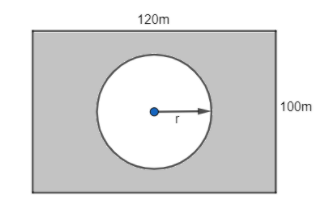
A park is in the form of a rectangle $120m\times 100m$ . At the centre of the park there is a circular lawn. The area of the park excluding the lawn is 8700 sq m. Find the radius of the circular lawn.
Answer
583.2k+ views
Hint: Start by finding the area of the whole rectangular park using the formula of area of rectangle, i.e., $l\times b$ and subtract the area of the park excluding lawn is 8700 sq m to get the area of the lawn. Now equate the area of the lawn to $\pi {{r}^{2}}$ , which is the area of the circle to get the radius of the circle.
Complete step-by-step answer:
Let us start the solution to the above question by drawing a representative figure of the situation given in the figure.

First let us find the area of the whole rectangular park. We know that the area of a rectangle is equal to length multiplied by breadth and for the park the length is 120m and breadth is 100m.
$\text{Area of the park}=l\times b=120\times 100=12000\text{ }{{\text{m}}^{2}}$
Now if we subtract the area of the shaded region, i.e., the area of the park excluding lawn which is 8700 sq m, we get the area of the circular lawn.
$\text{Area of the circular lawn}=12000-8700=3300\text{ }{{\text{m}}^{2}}$
Now we know that the area of the circle is equal to $\pi {{r}^{2}}$ .
$\pi {{r}^{2}}=3300$
\[\Rightarrow {{r}^{2}}=\dfrac{3300}{\pi }\]
If we take root of both the sides of the equation, we get
\[r=\sqrt{\dfrac{3300}{\pi }}\]
Now we will put $\pi =\dfrac{22}{7}$ .
\[r=\sqrt{\dfrac{3300\times 7}{22}}=\sqrt{1050}\simeq 32.4\text{ m}\]
Therefore, the answer to the above question is 32.4 m, approximately.
Note: Never put the value of $\pi $ in the initial steps, as the value of $\pi $ is a complicated decimal number which can make the calculations very complex. Also, we cannot find the exact value of square roots of numbers which are not perfect squares, because they are non terminating decimal numbers, so always approximate your answer in such cases.
Complete step-by-step answer:
Let us start the solution to the above question by drawing a representative figure of the situation given in the figure.

First let us find the area of the whole rectangular park. We know that the area of a rectangle is equal to length multiplied by breadth and for the park the length is 120m and breadth is 100m.
$\text{Area of the park}=l\times b=120\times 100=12000\text{ }{{\text{m}}^{2}}$
Now if we subtract the area of the shaded region, i.e., the area of the park excluding lawn which is 8700 sq m, we get the area of the circular lawn.
$\text{Area of the circular lawn}=12000-8700=3300\text{ }{{\text{m}}^{2}}$
Now we know that the area of the circle is equal to $\pi {{r}^{2}}$ .
$\pi {{r}^{2}}=3300$
\[\Rightarrow {{r}^{2}}=\dfrac{3300}{\pi }\]
If we take root of both the sides of the equation, we get
\[r=\sqrt{\dfrac{3300}{\pi }}\]
Now we will put $\pi =\dfrac{22}{7}$ .
\[r=\sqrt{\dfrac{3300\times 7}{22}}=\sqrt{1050}\simeq 32.4\text{ m}\]
Therefore, the answer to the above question is 32.4 m, approximately.
Note: Never put the value of $\pi $ in the initial steps, as the value of $\pi $ is a complicated decimal number which can make the calculations very complex. Also, we cannot find the exact value of square roots of numbers which are not perfect squares, because they are non terminating decimal numbers, so always approximate your answer in such cases.
Recently Updated Pages
Master Class 9 Social Science: Engaging Questions & Answers for Success

Master Class 9 Science: Engaging Questions & Answers for Success

Master Class 9 English: Engaging Questions & Answers for Success

Master Class 9 Maths: Engaging Questions & Answers for Success

Master Class 9 General Knowledge: Engaging Questions & Answers for Success

Class 9 Question and Answer - Your Ultimate Solutions Guide

Trending doubts
Which places in India experience sunrise first and class 9 social science CBSE

Fill the blanks with the suitable prepositions 1 The class 9 english CBSE

Write the 6 fundamental rights of India and explain in detail

Difference Between Plant Cell and Animal Cell

What is pollution? How many types of pollution? Define it

What is the Full Form of ISI and RAW




